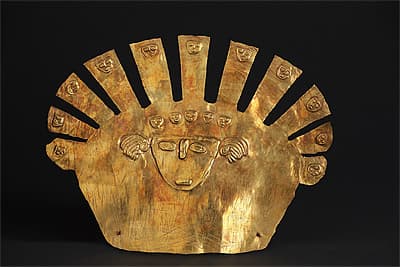
NAZCA culture South coast 100 – 700 AD
Forehead ornament 100-700 AD gold and cinnabar18.6 (h) x 24.3 (w) cm Ministerio de Cultura del Perú: Museo Nacional de Arqueología, Antropología e Historia del Perú, Photograph: Daniel Giannoni
The brilliant rayed ornament, perhaps a crown or headdress, was made by hammering gold into a sheet, cutting it into shape and polishing it. A main head with plumed ear ornaments is surmounted by five heads, with 11 squared rays each topped by heads. All were made in the repoussé technique—a thin metal sheet was placed over a hard anvil to push the forms out from underneath. The whole was painted with cinnabar, which is powdered red mercuric sulphide. At the base are two punched holes, used to attach the object to fabric wrapped around a corpse’s head or a mummy bundle.
Gold was noble and important, and represented the gods and the sun. Therefore the headdress was intended for a man of high status, probably a chief or priest. Johny Isla describes the work as an allegory of the sun. Decorated with human faces, it reaffirms the bond between people and nature, the wellspring of divine inspiration, foundation for their worldview, and source of all life.1
Christine Dixon
1. Johny Isla, ‘The Nazca culture’, in Peru: Art from the Chavín to the Incas, Paris and Milan: Paris-musées, Milan and Skira 2006, p. 65, fig. 68.
The brilliant rayed ornament, perhaps a crown or headdress, was made by hammering gold into a sheet, cutting it into shape and polishing it. A main head with plumed ear ornaments is surmounted by five heads, with 11 squared rays each topped by heads. All were made in the repoussé technique—a thin metal sheet was placed over a hard anvil to push the forms out from underneath. The whole was painted with cinnabar, which is powdered red mercuric sulphide. At the base are two punched holes, used to attach the object to fabric wrapped around a corpse’s head or a mummy bundle.
Gold was noble and important, and represented the gods and the sun. Therefore the headdress was intended for a man of high status, probably a chief or priest. Johny Isla describes the work as an allegory of the sun. Decorated with human faces, it reaffirms the bond between people and nature, the wellspring of divine inspiration, foundation for their worldview, and source of all life.1
Christine Dixon
1. Johny Isla, ‘The Nazca culture’, in Peru: Art from the Chavín to the Incas, Paris and Milan: Paris-musées, Milan and Skira 2006, p. 65, fig. 68.
The brilliant rayed ornament, perhaps a crown or headdress, was made by hammering gold into a sheet, cutting it into shape and polishing it. A main head with plumed ear ornaments is surmounted by five heads, with 11 squared rays each topped by heads. All were made in the repoussé technique—a thin metal sheet was placed over a hard anvil to push the forms out from underneath. The whole was painted with cinnabar, which is powdered red mercuric sulphide. At the base are two punched holes, used to attach the object to fabric wrapped around a corpse’s head or a mummy bundle.
Gold was noble and important, and represented the gods and the sun. Therefore the headdress was intended for a man of high status, probably a chief or priest. Johny Isla describes the work as an allegory of the sun. Decorated with human faces, it reaffirms the bond between people and nature, the wellspring of divine inspiration, foundation for their worldview, and source of all life.1
Christine Dixon
1. Johny Isla, ‘The Nazca culture’, in Peru: Art from the Chavín to the Incas, Paris and Milan: Paris-musées, Milan and Skira 2006, p. 65, fig. 68.

